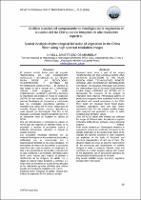Análisis espacial del comportamiento fenológico de la vegetación en la cuenca del rio Chira usando imágenes de alta resolución espectral
Metadata
Show full item recordAuthor(s)
Date
2009Collections
Related Resource(s)
https://web2.senamhi.gob.pe/rpga/pdf/2009_vol01/art3.pdfAbstract
El presente artículo forma parte del proyecto “MONITOREO DE LOS ECOSISTEMAS AGRICOLAS Y NATURALES EN LA REGION PIURA DESDE LAS TECNOLOGIAS: TELEDETECCION Y SISTEMAS DE INFORMACION GEOGRAFICA”. El objetivo de este trabajo es dar a conocer con la metodología utilizada desde (imágenes de satélite multitemporales LANDSAT y ASTER) y demostrar la importancia del análisis del índice de vegetación (NDVI). En este sentido, se ha logrado establecer patrones fenológicos de producción y crecimiento para los principales ecosistemas agrícolas y naturales en la cuenca del rio Chira: bosque seco de montaña, Bosque llanura, matorral, agricultura y suelo desnudo y/o desprotegido. Para ello se han analizado y procesado imágenes de satélite con el fin de seleccionar áreas de muestreo de valores de NDVI. Una vez seleccionados y colectados los valores de NDVI para las imágenes en distintas fechas, se ha procedido a analizar el ecosistema (natural o artificial) seleccionado, utilizando un método de análisis temporal. Los principales resultados obtenidos son: La variación fenológicos de los ecosistemas (naturales y artificiales) que se corresponden con la estacionalidad climática de las áreas estudiadas. En este sentido, la mayoría de los cambios y variaciones específicas para cada ecosistema son explicados en base a las características funcionales y estructurales de cada ecosistema. Los resultados obtenidos pueden servir como insumo para mejorar el proceso y clasificación de las imágenes de satélite con el objeto de elaborar mapas temáticos y contribuir a la mejor toma de decisiones en cuanto al uso adecuado de los calendarios agrícolas definidos para cultivos anuales y/o transitorios instalados en la cuenca. Presented study forms a part of the project “MONITORING OF THE AGRICULTURAL AND NATURAL ECOSYSTEMS IN THE PIURA REGION USING TECHNOLOGIES: REMOTE SENSING AND GEOGRAPHIC INFORMATION SYSTEMS“. The objective of this paper is to present the methodology used in the study (multi-temporal satellite images LANDSAT and ASTER) and to demonstrate the relevance of the analysis of vegetation index (NDVI). Phenological patterns of production and growth were established for the main agricultural and natural ecosystems in the Chira River basin: dry mountain forest, forest plains, scrubland, agricultural land and bare and/or unprotected soils. For this purpose satellite images were analyzed and processed in order to select sampling areas for NDVI values. Once the NDVI values were selected and collected for images of different dates, the selected ecosystem (natural or artificial) was analyzed, using a temporal analysis method. Main results obtained are: Phenological variations in ecosystems (natural and artificial) correspond to the climate seasonality in the studied areas. Most of the changes and specific variations in each ecosystem are explained on the basis of functional and structural characteristics of each one of them. The obtained results can serve as input for improvement of the processing and classification of satellite imagery in order to elaborate thematic maps and contribute to a better decision-making with respect to the appropriate use of agricultural calendars for annual and/or transitory crops in the basin.
The following license files are associated with this item:








